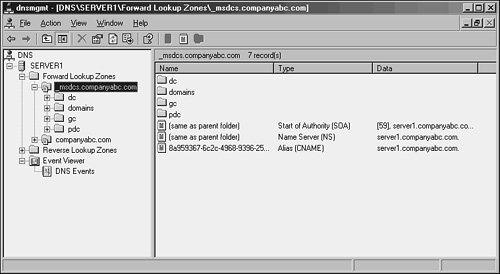DNS Changes in Windows Server 2003
| In addition to the changes in Windows 2000 DNS, the Windows Server 2003 improvements help to further establish DNS as a reliable, robust name-resolution strategy for Microsoft and non-Microsoft environments. An overall knowledge of the increased functionality and the structural changes will help you to further understand the capabilities of DNS in Windows Server 2003. DNS Is Stored in the Application PartitionPerhaps the most significant change in Windows Server 2003's DNS, Active Directoryintegrated zones are now stored in the application partition of the AD. For every domain in a forest, a separate application partition is created and is used to store all records that exist in each AD-integrated zone. Because the application partition is not included as part of the global catalog, DNS entries are no longer included as part of global catalog replication. Previously, in Windows 2000, all AD-integrated zones were stored as global catalog objects and replicated to all global catalog servers in an entire forest. Many times, this information was not applicable across the entire forest, and unnecessary replication traffic was created. Subsequently, the application partition concept was enacted, and replication loads are now reduced, while important zone information is delegated to areas of the network where they are needed. Automatic Creation of DNS ZonesThe Configure a DNS Server Wizard, as demonstrated in "Installing DNS Using the Configure Your Server Wizard" section, allows for the automatic creation of a DNS zone through a step-by-step wizard. This feature greatly eases the process of creating a zone, especially for Active Directory. The wizard can be invoked by right-clicking on the server name in the DNS MMC and choosing Configure a DNS Server. No "Island" ProblemWindows 2000 previously had a well-documented issue that was known as the "island" problem, which was manifested by a DNS server that pointed to itself as a DNS server. If the IP address of that server changed, the DNS server updated its own entry in DNS, but then other DNS servers within the domain were unable to successfully retrieve updates from the original server because they were requesting from the old IP address. This effectively left the original DNS server in an "island" by itself, hence the term. Windows Server 2003 DNS first changes its host records on a sufficient number of other authoritative servers within DNS so that the IP changes made will be successfully replicated, thus eliminating this "island" problem. As a result, it is no longer necessary to point a root DNS server to another DNS server for updates, as was previously recommended as a method of resolving this issue. Forest Root Zone for _msdcs Moved to Separate ZoneIn Active Directory, all client logons and lookups are directed to local domain controllers and global catalog servers through references to the SRV records in DNS. These SRV records were stored in a subdomain to an Active Directory domain that was known as the _msdcs subdomain. In Windows Server 2003, _msdcs has been relocated to become a separate zone in DNS, as shown in Figure 9.18. This zone, stored in the application partition, is replicated to every domain controller that is a DNS server. This listing of SRV records was moved mainly to satisfy the requirements of remote sites. In Windows 2000, these remote sites had to replicate the entire DNS database locally to access the _msdcs records, which led to increased replication time and reduced responsiveness. If you delegate the SRV records to their own zone, only this specific zone can be designated for replication to remote site DNS servers, saving replication throughput and increasing the response time for clients. Figure 9.18. The _msdcs zone. |
EAN: 2147483647
Pages: 499
- Understanding SQL Basics and Creating Database Files
- Using SQL Data Definition Language (DDL) to Create Data Tables and Other Database Objects
- Using SQL Data Manipulation Language (DML) to Insert and Manipulate Data Within SQL Tables
- Understanding Transaction Isolation Levels and Concurrent Processing
- Repairing and Maintaining MS-SQL Server Database Files